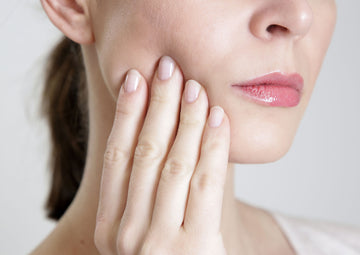

Teeth whitening may be one of the easiest and best ways to quickly improve your appearance, but when first exploring your options for brightening your smile, you may wonder “Is teeth whitening safe?"
It is always a good idea to research any product you will be putting in or on your body, and whitening products are no different. Even though at home whitening products have been used effectively by thousands of people every year, you should be aware that there are occasional mild side effects.
Can Teeth Whitening Damage Your Gums?
Whitening gels, like those available from AuraGlow.com, all contain the active ingredients like carbamide peroxide or hydrogen peroxide, which oxidize dark colors and effectively whiten your teeth.
These same compounds, if they get onto your gum tissue in significant amounts, can also burn or cause your gums to turn white temporarily.
In almost all cases, removing the gel will stop the irritation and your gums will return to their normal color in a short while.
How To Treat Sore Gums After Teeth Whitening?
If you have irritated or burned gums from teeth whitening, the first thing you need to do is to remove all the gel from your gum tissue. Wipe away all excess that may have gotten onto your gums and then rinse with warm salt water. This both helps remove residual gel and helps soothe and heal your gum tissues.
If soreness continues, you can take over the counter pain relievers such as ibuprofen to help with the symptoms and apply vitamin E oil to the irritated tissues as needed. Symptoms should not last more a few days.
How To Protect Gums During Teeth Whitening?
The most common cause of gum irritation or bleaching around the teeth after using at home whitening products is using too much product at once. If you see or feel whitening gel on your gum tissues, then be conscious of the amount you are placing the next time you whiten.
If the material is flowing out over your gums, then you are likely using too much. Lessen the amount of gel you are putting into your applicator tray the next time you whiten until it covers your teeth but does not ooze out over your gums.
Alternatively, consider using a teeth whitening pen. Take care to keep the whitening product only on your teeth and off of your gums.
Best Teeth Whitening For Sensitive Gums
Sensitive gums are a common issue with many tooth whitening methods, especially those containing active ingredients such as hydrogen peroxide or carbamide peroxide. If these products come in contact with the gum tissue for too long, they may result in irritation, burning, or temporary blanching of the gums.
If your issue is simply tooth staining from things like coffee or nicotine instead of tooth enamel discoloration, you may want to initially use whitening toothpastes or try natural methods to see if they help.
These products usually do not irritate the gums. Just be aware that such products are great at removing stain from the outside of the teeth, but do not actually change the color of the tooth enamel itself.
If these methods are unable to get you the bright smile you desire, then consider stepping up to an at home gel like our carbamide peroxide teeth whitening gel or our Radiant Effects Kit with teeth whitening trays.
Using custom trays helps keep the whitening gel in place on your teeth and off your gums. Just be sure to use only a small amount of gel in each tooth indentation on the trays to prevent oozing onto your gum tissues.
There are many available options when it comes to tooth whitening. In general, the stronger, more aggressive the whitening method, the more potential there is for irritation or sensitivity.
By knowing how to best use these whitening methods, however, you can safely and effectively achieve the bright smile you desire with minimal to no discomfort.




